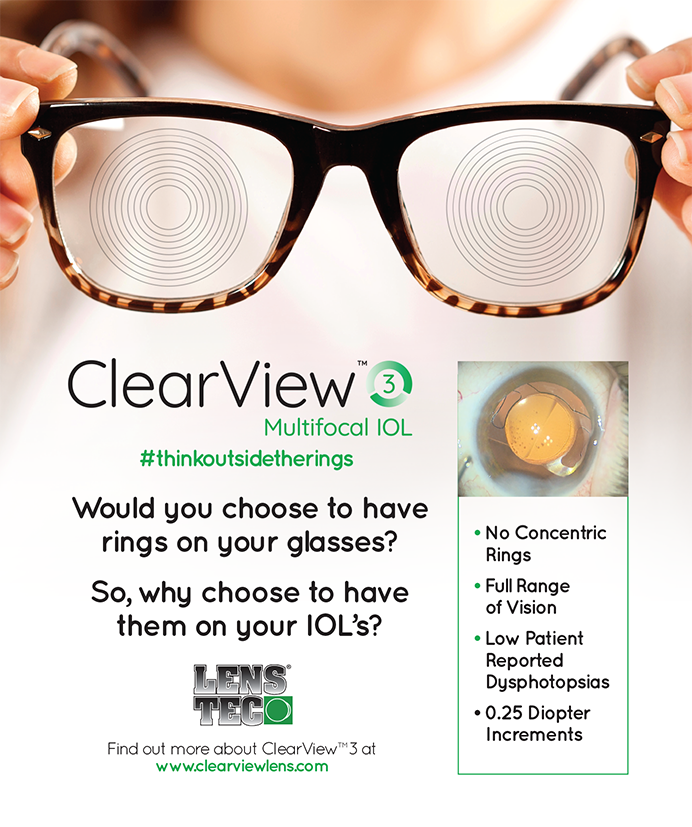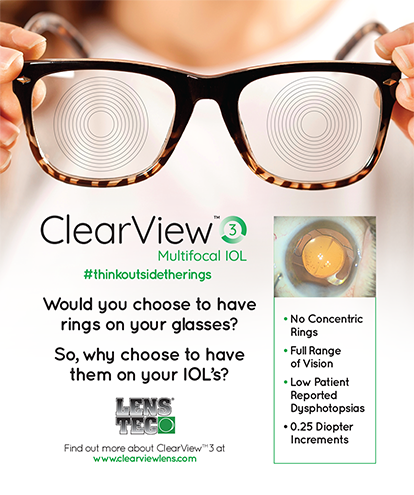During the past 3 years, Alcon Laboratories, Inc. (Fort Worth, TX), Abbott Medical Optics Inc. (Santa Ana, CA), and Bausch & Lomb (Rochester, NY) have provided upgrades to their presbyopia-correcting IOLs that have incrementally improved visual outcomes. In a perfect world, surgeons would be able to select a specific IOL for patients, and patients would uniformly achieve spectacle independence and experience a perfectly smooth postoperative course. Unfortunately, achieving spectacle freedom with presbyopia-correcting IOLs is challenging. A careful inspection of the ocular surface and lid margin prior to surgery is an important element in success. In addition, performing preoperative topography helps to identify conditions such as keratoconus, pellucid marginal degeneration, and/or irregular astigmatism. Physicians obtain optical coherence tomography of the macula is obtained to screen for epiretinal membranes and vitreomacular traction syndrome. All of these tests are important so that the surgeon can determine which patients are eligible for presbyopia-correcting IOLs.
To further improve outcomes, surgeons typically prescribe a topical antibiotic and nonsteroidal anti-inflammatory drugs (NSAIDs) preoperatively, and they instruct patients to continue using these medications with a topical steroid postoperatively. In my practice, I initiate a topical NSAID (along with a fourth-generation fluoroquinolone) 3 days prior to surgery, and continue the topical NSAID and steroid for 4 weeks postoperatively, they continue the topical antibiotic for 10 days postoperatively. This therapy reduces the risk of infection and suppresses postoperative inflammation. The combination of the topical steroid and NSAID also reduces the risk of developing cystoid macular edema.1,2 A number of medications approved by the FDA during the past 12 months or so can help presbyopic patients achieve improved visual outcomes after IOL surgery and enhance the comfort of their postoperative course. Several other agents may receive approval within the next 6 to 12 months. Surgeons can now start to determine which medications are most helpful to patients undergoing the implantation of presbyopia-correcting IOLs.
TREATMENTS FOR BLEPHARITIS
Standard preoperative therapies such as topical cyclosporine, punctal plugs, artificial tears, and lid scrubs can enhance the results of IOL surgery by improving the ocular surface.3 Blepharitis is a common problem, but its impact on surgical outcomes may be underappreciated. The condition can cause fluctuations in vision and reduce visual quality. The treatment of blepharitis has evolved with the development of AzaSite (azithromycin 1%; Inspire Pharmaceuticals, Inc., Durham, NC), which is a combination of azithromycin 1% and the vehicle DuraSite (InSite Vision, Inc., Alameda, CA). In early clinical studies, 2 to 4 weeks of AzaSite q.h.s. improved patients' symptoms and the quality of their meibomian gland secretions.4,5 How AzaSite treats blepharitis, however, is under debate.
Recently, Gary Foulkes, MD, found that patients with blepharitis who were treated with AzaSite had a reduction in the melting point of the meibomian gland oils at each weekly visit during more than 4 weeks of treatment.6 At body temperature, therefore, the lipid secretions are likely to be a liquid oil rather than a thick (solid) lipid secretion. Dr. Foulkes also found azithromycin in the oil secretions that were collected from patients. His study supports the role of AzaSite in the treatment of blepharitis and indicates that treating patients prior to cataract surgery is crucial to ensuring excellent visual outcomes.
DRY EYE
Dry eye disease may occur independently or in association with blepharitis. Several studies have looked at new lubricating drops that can help improve visual outcomes after surgery. Peter Simmons, PhD, and colleagues found that Optive Preservative-free (Allergan, Inc., Irvine, CA) was as effective as Refresh Preservative-free (Allergan, Inc.) in a multicenter study of patients undergoing LASIK.7 Preservative-free Blink Tears (Abbott Medical Optics Inc.), a hyaluronic acid-based artificial tear, may be another excellent option for patients postoperatively. In a study of more than 200 LASIK patients, subjects reported a greater improvement in visual quality with Blink Tears compared with other drops.8 Vismed (Lantibio, Inc., Chapel Hill, NC), a hyaluronic acid-based tear, is popular in Europe but not yet approved in the United States. According to the results of a multicenter study presented at the 2009 annual ARVO meeting, treatment with Vismed improved clinical and symptomatic parameters in patients with dry eyes more effectively than the vehicle.
Artificial tears can help patients achieve a smooth postoperative course.9
INFECTION
A multicenter study found that more than 40% of all eyes with positive cultures had methicillin-resistant Staphylococcus species.10 Antibiotic prophylaxis is therefore crucial to avoiding infection. Currently, fourth-generation fluoroquinolones appear to effectively reduce the risk of infection.11 For patients with blepharitis, which is associated with Staphylococcus, treatment with topical antibiotics may help reduce the bacterial load at the time of cataract surgery.
The FDA recently approved besifloxacin 0.6% (Besivance; Bausch & Lomb). Dosed t.i.d., one property of this medication is its vehicle, Durasite, which can prolong the drug's contact time with the eye after administration. Further studies are needed to determine how this antibiotic compares with the other fourth-generation fluoroquinolones.
INFLAMMATION
Suppressing inflammation after cataract surgery can improve visual outcomes. A recent addition to ophthalmologists' armamentarium is Durezol (difluprednate ophthalmic emulsion, 0.05%; Sirion Therapeutics, Inc., Tampa, FL), which in a few studies appeared to be two to three times more potent than Pred Forte 1% (prednisolone acetate; Allergan, Inc.).12 In a recently completed pilot study, Eric D. Donnenfeld, MD; Edward J. Holland, MD; and Kerry D. Solomon, MD, found that the pulsed dosing of Durezol on the day of surgery and the first postoperative day reduced corneal swelling more effectively than the standard dosing regimen with Pred Forte 1% (oral communication, May 2009). If the larger study confirms these results, then patients receiving a pulsed dose of Durezol should experience thinner corneas and better vision 1 day postoperatively.
IN SUMMARY
A number of recently approved pharmaceutical agents help improve the outcome of IOL surgery, and several more drugs are currently under review by the FDA. Surgeons can carefully begin to determine which medications are of greatest benefit to patients undergoing the implantation of presbyopia-correcting IOLs.
William B. Trattler, MD, is the director of cornea at the Center for Excellence in Eye Care in Miami. He has received funding for research, consulting, and/or speaking from Abbott Medical Optics Inc., Allergan, Inc., Inspire Pharmaceuticals, Inc., and Sirion Therapeutics, Inc. Dr. Trattler may be reached at (305) 598-2020; wtrattler@earthlink.net.
- Wittpenn JR, Silverstein S, Heier J, et al. A randomized, masked comparison of topical ketorolac 0.4% plus steroid versus steroid alone in low-risk cataract surgery patients. Am J Ophthalmol. 2008;146(4):554-560.
- Donnenfeld ED, Perry HD, Wittpenn JR, et al. Preoperative ketorolac tromethamine 0.4% in phacoemulsification outcomes: pharmacokinetic-response curve. J Cataract Refract Surg. 2006;32(9):1474-1482.
- Donnenfeld E, Perry H, Roberts C, et al. Efficacy of topical cyclosporine versus tears for improving visual outcomes following multifocal IOL implantation. J Cataract Refract Surg. In press.
- Luchs J. Efficacy of topical azithromycin ophthalmic solution 1% in the treatment of posterior blepharitis. Adv Ther. 2008;25(9):858-870.
- John T, Shah AA. Use of azithromycin ophthalmic solution in the treatment of chronic mixed anterior blepharitis. Ann Ophthalmol (Skokie). 2008;40(2):68-74.
- Foulks GN, Borchman D, Yappert M. Modification of meibomian gland lipids by topical azithromycin. Poster presented at: The 2009 ARVO meeting; May 5, 2009; Fort Lauderdale, FL.
- Simmons PA, Gilbert M, Lai F, Vehige JG. Artificial tear use improves objective signs and visual symptoms of dry eye. Paper presented at: The 2009 ARVO meeting; May 6, 2009; Fort Lauderdale, FL.
- Slade SG. Blink Tears lubricating eye drops positively impacts HOA. Artificial tear preferences in post-LASIK patients. Paper presented at: The 2009 ASCRS Symposium on Cataract, IOL and Refractive Surgery; April 2009; San Francisco, CA.
- Kirby CA, The Vismed Study Group. Superiority of Vismed (sodium hyaluronate ophthalmic solution 0.18%) compared with its vehicle in the treatment of the signs and symptoms of dry eye disease. Poster presented at: The 2009 ARVO Meeting; May 6, 2009; Fort Lauderdale, FL.
- Randall O, Donnenfeld E, Bucci F, et al. Methicillin resistance of Staphylococcus species among healthcare and non-healthcare workers undergoing cataract surgery. Poster presented at: The AAO Annual Meeting, November 9, 2008; Atlanta, GA.
- Jensen MK, Fiscella RG, Moshirfar M, Mooney B. Third- and fourth-generation fluoroquinolones: retrospective comparison of endophthalmitis after cataract surgery performed over 10 years. J Cataract Refract Surg. 2008;34(9):1460-1467.
- Korenfeld MS, Silverstein SM, Cooke DL, et al. Difluprednate ophthalmic emulsion 0.05% for postoperative inflammation and pain. J Cataract Refract Surg. 2009;35(1):26-34.


